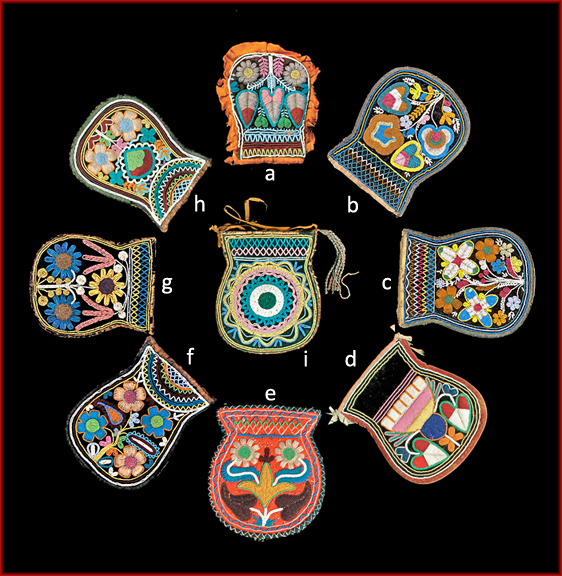The Wabanaki from Maine, New Brunswick and Nova Scotia also produce beaded bags for the souvenir trade and they have features that vary from those seen on Iroquois work. Their contour, for instance, is often in the shape of a vase or an inverted keyhole, though there are exceptions to this. The flowers and leaf patterns on these bags are stylistically distinctive. Many of the flowers are daisy-like and can have as many as 15 petals or as few as five and they usually have squared-off or gently rounded ends. There aren’t as many of these bags as the Haudenosaunee examples, perhaps because the Wabanaki were more involved in the basket trade. Examples in this style generally originate from the third and fourth quarters of the nineteenth century.
The leaf patterns on these bags are often in the shape of a heart (examples b & d) or ovate (example a), and usually fully beaded. Like the Iroquois, the Wabanaki also incorporated paper patterns upon which their flower and leaf designs were beaded. The main stem of the floral design often rises from the center base of the bag in a flat bundle of beads, each string of which connects to a flower or leaf. These stems occasionally had bi-lobed or tri-lobed buds or ears connected to them. Generally, this style of Wabanaki bag didn’t have a two-bead or zippered edging along the outside.
A rare and beautiful example of Wabanaki beadwork is example (i) in the center of this image. It has a large sun motif as the focal point of the design. This piece incorporates a limited color palette, suggesting a mid 19th century origin. The other side (example g) has three symmetrically placed daisy-like flowers with 12 petals, each connected to the center base of the bag by a single string of white beads. Some of the floral elements along the stem and at the top are suggestive of the double-curve motif.
The vast majority of these are identified as Maliseet and occasionally they are assigned to the Passamaquoddy or the Mi’kmaq.
The beadwork that was produced by Wabanaki artists varied over time. Bags from the 1830s to the 1850s often employed bi-laterally symmetrical designs that are relatively linear in their execution and they incorporated limited areas of solid bead fill. The inverted keyhole shape is occasionally encountered and examples from this period often include the double-curve motif. Early bags that were beaded over paper patterns are not known to exist. Empirical studies indicate that like the Haudenosaunee, the earliest Wabanaki bags had linear designs and no areas of solid bead fill. The paper patterns appear to be a feature found on later bags and for the most part on the vase or inverted keyhole shaped examples.
A beaded stitch along the outside edge binding is uncommon on Wabanaki bags. Some early examples have a similar shape to the Iroquois hexagonal bags, though the sides are more rounded and less segmented than the Haudenosaunee examples. As a general rule, the earliest inverted keyhole shaped bags have bilaterally symmetrical designs while those on later examples are asymmetrical. Virtually all the inverted keyhole shaped bags known to exist incorporated motifs that were solidly filled with beads, suggesting their construction post-dates the hexagonal shaped examples.
